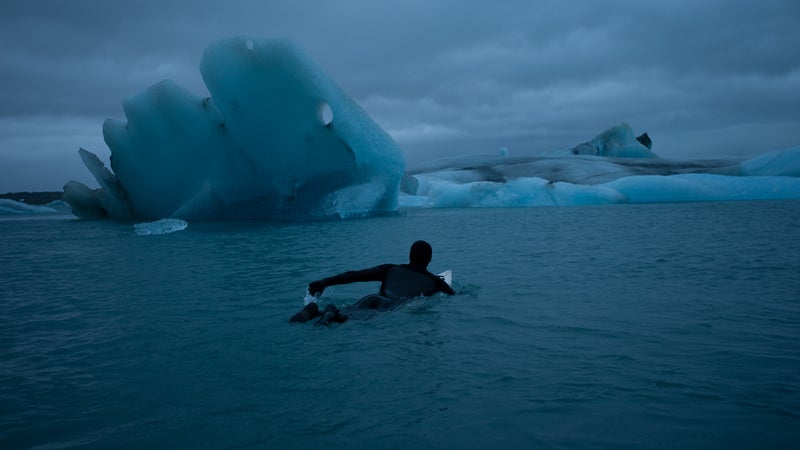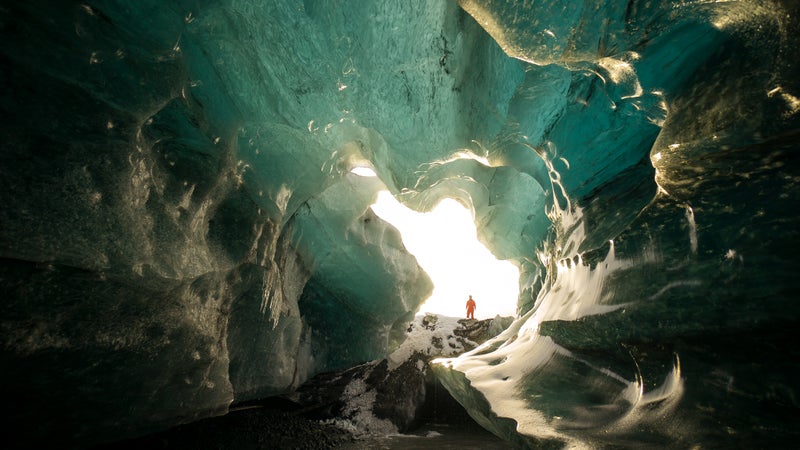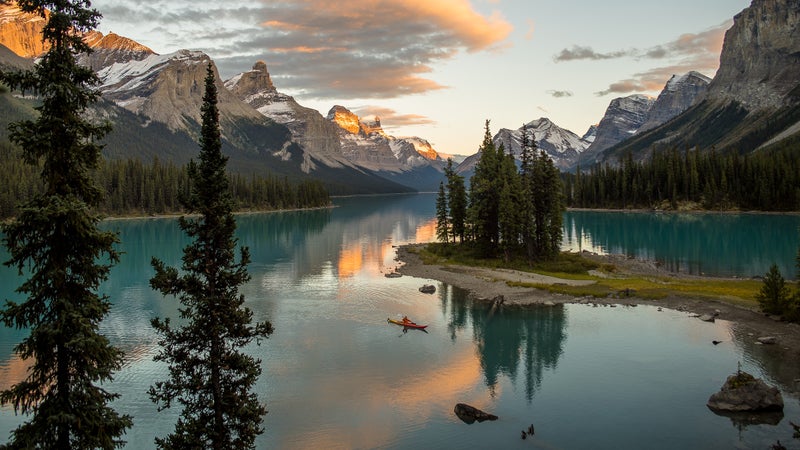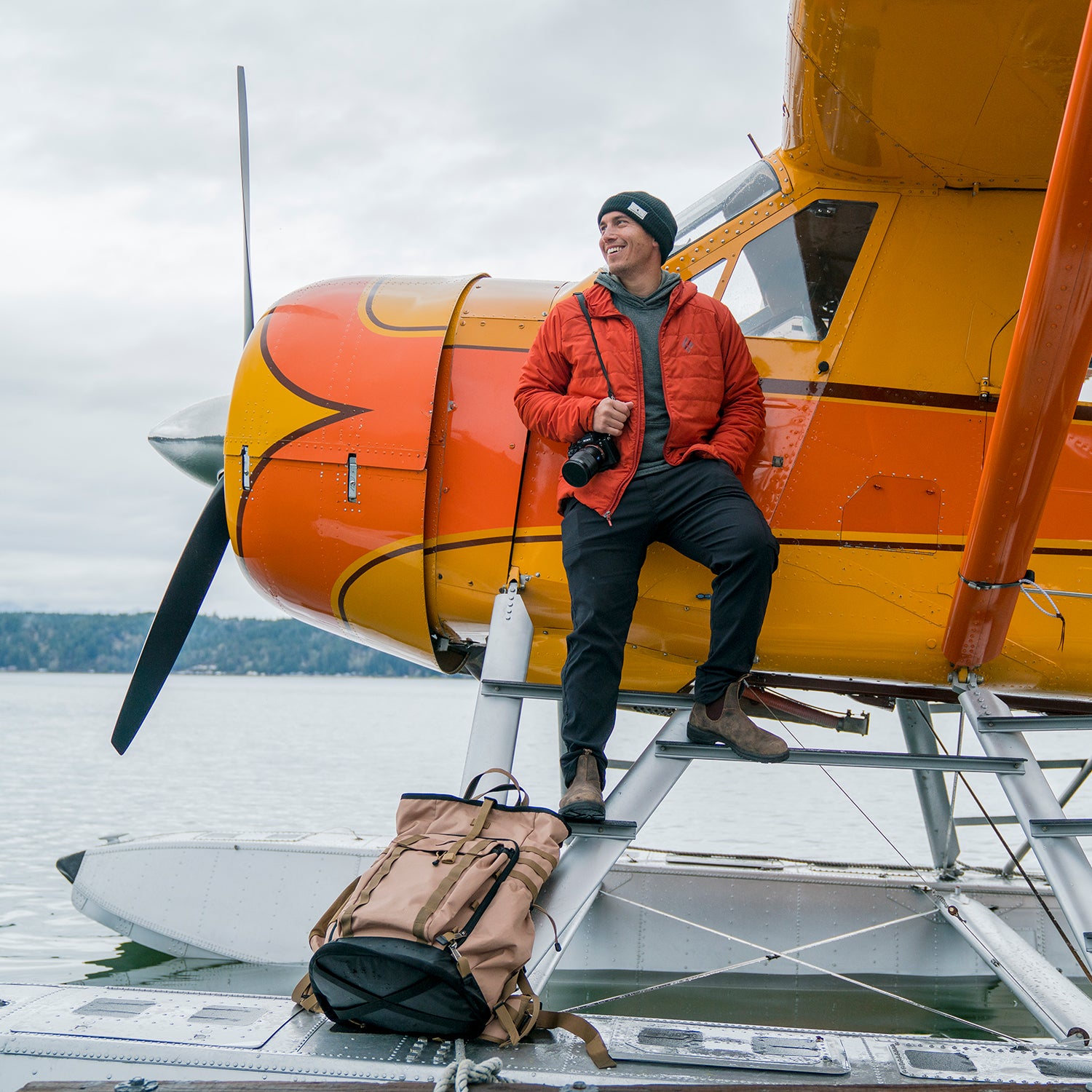It’s early November, and head-high surf pounds the Pismo Beach Pier, on California’s central coast. But has solid footing on the railing. Without hesitation he bends his knees, pivots 180 degrees, and backflips into the great Pacific washing machine. I lose sight of him for what feels like a minute before he appears in the whitewash. Another monster wave rumbles in. Burkard catches it and bodysurfs to shore.
“That’s not warm,” he yells, shaking out his wet hair like a dog. “I don’t drink coffee. I have a hard time focusing, but all I need to do is jump in the ocean.”
“Not warm” is hard to believe coming from someone who treads water next to icebergs. When the 32-year-old photographer isn’t working in eastern Greenland or Alaska, he’s here, dropping his core temperature at the beach where he grew up and his career began 13 years ago. With around 100 magazine covers to his credit—plus sponsors like Black Diamond and Sony, prestigious awards, a TED Talk that’s been viewed almost two million times, a catalog of films and books, and three million Instagram followers—Burkard could go freeze anywhere he likes. Yet, with his wife, Breanne, and two sons (Jeremiah, six, and Forrest, four), as well as a studio just down Highway 101, he’d like to spend more than about three months a year at home. “This is one of California’s last funky beach towns,” Burkard says of Pismo, peering through bloodshot blue eyes at tourist shops and cafés. “When I was a teenager, I turned to photography as a way to get out of here. Now there’s nowhere else I’d rather be.”
A Road Few Travel
Watch “Passion,” an episode about Burkard in ���ϳԹ��� TV's series A Road Few Travel, on July 2We jump into his well-worn Transit Connect camper, and I spot his passport resting below the stereo. He used it 48 hours prior to get home from his 27th trip to Iceland, where he was hired to explore the Westfjords with surfer Stephanie Gilmore and the band MGMT. “Have you posted a ’gram yet today?” I joke, to which Burkard throws his head back, resigned to the fact that he might be labeled an Instagram influencer for eternity. His posts often get more than 100,000 likes and hundreds of comments. “I want to shoot photographs that will be here a lot longer than I am,” he says. “But my goal has always been to reach as many people as I can, so I’m really grateful that Instagram has taken my career and given it a megaphone.”

Kingdom of Ice
In praise of wild and frigid places
For this photo, Burkard convinced his friend, big-wave surfer Keith Malloy, to hop on a last-minute flight with him and go hunt swells on the south coast of Iceland. Midtrip, though, they reached the glacial lagoon Jökulsárlón and spent an hour paddling around icebergs.
We pull into Chris Burkard Studio, a renovated warehouse tucked behind the Pismo Beach Outlets, which he opened in July 2016. His images cover the walls. You know one when you see it: a surreally beautiful landscape is almost always the main character. “He’s really good at placing small humans in big spaces,” says Surfer magazine photo editor Grant Ellis, who has worked with Burkard for 12 years. “He has a distinctive style of showing the beauty of a place through color and stillness. He steps back and lets the scene be.”
It wasn’t until Burkard, at 19, borrowed a film camera from Breanne’s mother that he discovered the power of photography. He eventually purchased a digital Canon 20D and a waterproof housing, and taught himself how to artfully combine energetic oceanscapes with surfers. In 2006, he landed an internship at TransWorld Surf, the same year he was awarded a $5,000 grant from the Follow the Light Foundation, launched by the family and colleagues of former Surfing photo editor Larry Moore. Burkard used the money to fund a two-month road trip from Oregon to Mexico with his friend Eric Soderquist, resulting in a photo book called . By 2009, Burkard was spearheading feature expeditions for Surfer, where he’s still on the masthead as a senior photographer.
“All I really care about is shooting photos that make people want to be there and inspire action in some way, getting away from their desk or from school to see what the world has to offer,” Burkard says. “That’s what images did for me as a kid.”
Burkard was ahead of the class when it came to embracing digital photography. And when most surf photographers were jostling for position in Hawaii or Tahiti, he was scouring satellite swell maps of Kamchatka, Russia; Unstad, Norway; and Alaska’s Aleutian Islands. He assembled teams of assistants and athletes and joined Instagram early on to share behind-the-scenes footage and personal stories of what it took to get to those places. Gradually, his audience and client list grew.

On Burkard’s first winter trip to Iceland, in 2012, he and some friends set out before dawn, hiked up a glacier, descended fixed ropes, and took a dinghy across a tiny river to get to this cavern by sunrise.
“What separates Chris is his work ethic,” says climber and photographer Jimmy Chin. “He has built an incredible presence on Instagram, but it didn’t come easy. He has consistently put out great work, beautiful work, unexpected work, for years. People love his vision, but they also love his voice, which comes out in his captions.”
Today, Burkard focuses on personal projects, commercial jobs for clients like Apple, the North Face, and Toyota, and photography workshops, which this year include a six-day course in Colorado and a sailing trip around northwest Norway. He provides students with a blend of theory, technique, and social-media tips. “I don’t really know how to get millions of followers,” Burkard says. “If there’s one thing I have noticed, it’s that the more I’ve been able to be honest and open up and share the actual things that make me tick in captions, people seem to care about that.” He also tries to post consistently, once or twice a day, and encourages students to draft a mission statement. His most emphatic advice: don’t tell viewers what they can already see. “The worst thing you can do as a photographer is pair a beautiful piece of work with a crappy, regurgitated caption. If I read ‘The mountains are calling and I must go’ one more time,” he laughs. “Social media is the place where you make your own quotes.”
Burkard’s captions range from honoring nature (“There are few places where you can feel precipitation rising upward. This is one of them,” about an image in Kauai), to photography advice (“A good leading line not only pulls the viewer in but also helps them to focus on what is important in the frame”), to personal disclosure (“A sad but real by-product of Social Media is that it can create an ever present need for recognition. It has become more and more obvious to me how important it is to be in environments that humble you, scare you, and ultimately challenge who you are”).

After paddling seven miles with a friend on Maligne Lake, in Canada’s Jasper National Park, Burkard shot this photo of Spirit Island at sunset before camping out in the cold.
Burkard’s work has always steered toward environmental advocacy. Recently he teamed up with the National Park Foundation to raise the profile of lesser known natural playgrounds, like Colorado’s Great Sand Dunes and Arizona’s Canyon de Chelly; he’s also working on a book of aerial photography of the glacial rivers in Iceland’s central highlands. (Some of the proceeds will go toward a campaign to designate the threatened area as a national park.) Then there’s his growing interest in directing films, including last year’s Tribeca selection , about a quest to surf under the northern lights in Iceland.
How Burkard accomplishes all this is hard to fathom. Longtime colleague and Under an Arctic Sky cinematographer Ben Weiland says he has an uncanny ability to focus during high-pressure situations, like the 11-hour drive the crew took during one of Iceland’s worst snowstorms in 25 years. When their truck got stuck in a snowdrift on the edge of a sea cliff, Burkard jumped into the blizzard to guide the group out. “He thrives in situations like that,” Weiland says. “He never stops.”


